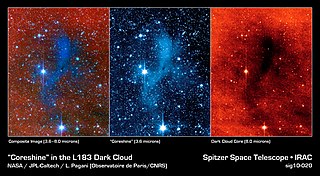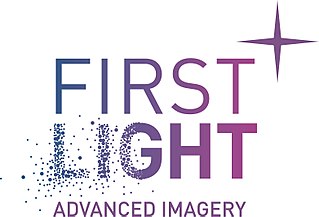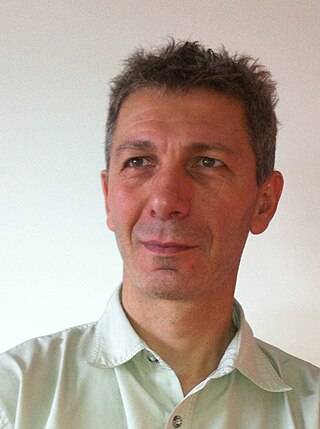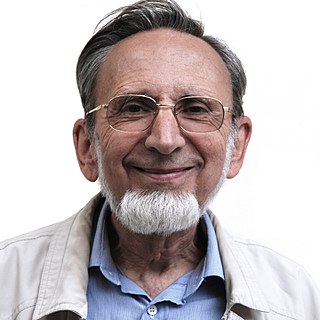Related Research Articles

Sandra Moore Faber is an American astrophysicist known for her research on the evolution of galaxies. She is the University Professor of Astronomy and Astrophysics at the University of California, Santa Cruz, and works at the Lick Observatory. She has made discoveries linking the brightness of galaxies to the speed of stars within them and was the co-discoverer of the Faber–Jackson relation. Faber was also instrumental in designing the Keck telescopes in Hawaii.

Michel Gustave Édouard Mayor is a Swiss astrophysicist and professor emeritus at the University of Geneva's Department of Astronomy. He formally retired in 2007, but remains active as a researcher at the Observatory of Geneva. He is co-laureate of the 2019 Nobel Prize in Physics along with Jim Peebles and Didier Queloz, and the winner of the 2010 Viktor Ambartsumian International Prize and the 2015 Kyoto Prize.

The Canada–France–Hawaii Telescope (CFHT) is located near the summit of Mauna Kea mountain on Hawaii's Big Island at an altitude of 4,204 meters, part of the Mauna Kea Observatory. Operational since 1979, the telescope is a Prime Focus/Cassegrain configuration with a usable aperture diameter of 3.58 metres (11.7 ft).

Marseille Observatory is an astronomical observatory located in Marseille, France, with a history that goes back to the early 18th century. In its 1877 incarnation, it was the discovery site of a group of galaxies known as Stephan's Quintet, discovered by its director Édouard Stephan. Marseille Observatory is now run as a joint research unit by Aix-Marseille University and the French National Center for Scientific Research (CNRS).

Jean-Pierre Luminet is a French astrophysicist, specializing in black holes and cosmology. He is an emeritus research director at the CNRS. Luminet is a member of the Laboratoire d'Astrophysique de Marseille (LAM) and Laboratoire Univers et Théories (LUTH) of the Paris-Meudon Observatory, and is a visiting scientist at the Centre de Physique Théorique (CPT) in Marseilles. He is also a writer and poet.

Catherine Jeanne Cesarsky is an Argentine and French astronomer, known for her research activities in astrophysics and for her leadership in astronomy and atomic energy. She is the current chairperson of the Square Kilometre Array's governing body, SKAO Council. She was the first female president of the International Astronomical Union (2006-2009) and the first female director general of the European Southern Observatory (1999-2007).

The Bordeaux Observatory is an astronomical observatory affiliated with the University of Bordeaux. Built in Floirac, France in 1893 its lenses were focused between +11 and +17 degrees declination. Until 1970 it had taken over 4,000 photographic plates. Bordeaux Observatory is home to a large collection of instruments and archives from well over a century of astronomical activities. Until the 2016 it was actively used until the institution moved to a new location at the University. In the French language the name is Observatoire de Bordeaux.

Jean-Claude Pecker was a French astronomer, astrophysicist and author, member of the French Academy of Sciences and director of the Nice Observatory. He served as the secretary-general of the International Astronomical Union from 1964 to 1967. Pecker was the President of the Société astronomique de France (SAF), the French amateur astronomical society, from 1973–1976. He was awarded the Prix Jules Janssen by the French Astronomical Society in 1967. A minor planet is named after him. Pecker was a vocal opponent of astrology and pseudo-science and was the president of the Association française pour l'information scientifique (AFIS), a skeptical organisation which promotes scientific enquiry in the face of quackery and obscurantism.

Coreshine is an astronomical term for infrared light scattered by unusually large grains of dust in the denser core regions of molecular clouds and which evidently begin their growth before the start of cloud collapse. These clouds which are opaque to visible light, are a mixture of gas and dust and are the regions where stars are formed.

Françoise Combes is a French astrophysicist at the Paris Observatory and a professor at the Collège de France where she has been the chair of Galaxies and cosmology since 2014.

The Prix Jules Janssen is the highest award of the Société astronomique de France (SAF), the French astronomical society.

Laura Ferrarese is a researcher in space science at the National Research Council of Canada. Her primary work has been performed using data from the Hubble Space Telescope and the Canada-France-Hawaii Telescope.

First Light Imaging is a French company headquartered in Meyreuil near to Aix-en-Provence, France. The company designs and manufactures scientific cameras for visible and infrared spectra based on EMCCD, e-APD. and InGaAs technologies.
Anne-Marie Lagrange, born March 12, 1962 in the Rhône-Alpes region of France, is a French astrophysicist. Lagrange's work focuses on the research and study of extrasolar planetary systems. Lagrange is the holder of numerous scientific awards and honorary decorations, including Knight of the Legion of Honour and is a member of the French Academy of Sciences since 2013.

Denis Burgarella is a French astrophysicist at Laboratoire d'astrophysique de Marseille.
Olivier Le Fèvre was a French astrophysicist who studied galaxies using multi-object spectroscopy.
Evangelia (Lia) Athanassoula is a retired Greek astrophysicist known for her numerical simulations of the dynamics and structure of disc galaxies, and her studies of the fit between theory and observation for these galaxies.

François Roddier was a French physicist and astronomer.
Arthur Vigan is a French astrophysicist known for his work on the study of exoplanets using the direct imaging technique, and on the development of novel instrumentation related to that detection method. He is a full time researcher at Centre National de la Recherche Scientifique (CNRS) and works at Laboratoire d'Astrophysique de Marseille. In 2021 he received the CNRS Bronze Medal for his early career achievements.
References
- ↑ "International Astronomical Union | IAU". www.iau.org. Retrieved 2017-09-22.
- ↑ "Emmanuel HUGOT - LAM - Laboratoire d'Astrophysique de Marseille". www.lam.fr (in French). Archived from the original on 2018-07-04. Retrieved 2017-09-22.
- ↑ "Proceedings of the annual meeting of the French Society of Astronomy & Astrophysics" (PDF).
- ↑ Switzerland, Marc Türler and Mathias Beck, ISDC, Observatory of the University of Geneva. "MERAC Prizes". eas.unige.ch. Retrieved 2017-09-22.
{{cite web}}: CS1 maint: multiple names: authors list (link) - ↑ CNRS. "CNRS - Médailles de bronze - Palmarès 2017". www.cnrs.fr. Archived from the original on 2011-03-07. Retrieved 2017-09-22.
- ↑ "Jean Jerphagnon Award".
- ↑ "Georges Lake Award".